Reno and Russia with Jude Gabbard (Part 1)
I don’t drink coffee, so let’s have a beer… My posts are always collaborations and are presented in two parts. Part 1 is a summary of a shared experience with my collaborator(s). Part 2 is a response often in the form of a project created specifically for this blog.

Jude Gabbard, and me wearing Jude Gabbard
My collaborator for the next two posts is San Francisco based fashion designer Jude Gabbard. Jude and I have been friends for about four years, and I wear his amazing designs often. We recently met at Bocadillos for some delicious tapas and drinks and talked about our upcoming projects and why our friendship has blossomed over the years. To follow up on our conversation I sent Jude some questions…
Meg: Jude, let’s start our conversation with your most recent project. I understand that you’re the first fashion designer to create a runway event for Reno’s infamous NadaDada event. What inspired you to take on this opportunity?
Jude: NadaDada is starting to gain steam and the timing just seemed right. It’s still a pretty raw, non-juried event with various levels of artists, and Reno is an amazing place. A onetime rival of Vegas, it’s sort of the Detroit of the West. There are abandoned buildings wasted spaces and a slew of old Motels trapped in amber. It still somehow manages to be a young city with a lot of young creative people. I always associate it with the film The Misfits or with Mark Twain.
I’m always looking for new projects that underscore the intersection of fashion and fine art. Decommodification is always at the back of my mind when I’m making things or looking at projects. I never ask who will buy this; I only ask whether this is my creative best. NadaDada seems like the perfect venue to share my work this June.
Meg: Tell me about the collection you’re creating.

Max Ernst’s postage-sized Microbes were inspired by the Nevada desert.
Jude: NadaDada was inspired by the Dada movement of the early 20th c. What a lot of people don’t realize is there is a historic connection between Reno and the Surrealists, particularly Max Ernst.
I’ve been in love with Nevada and the Surrealists for most of my life. They’re both so rebellious and untamed. I’ve taken these two ideas as a starting point for my newest collection; particularly Max Ernst’s arrival in Nevada in the 40s. After experiencing Europe at the dawn of Modernism and the horrors of WWII, imagine what it would have been like to see the wide-open Nevada desert for the first time, all fiery and rocky, neon and mysterious.
I’m taking some of the Surrealist / Dadaist mediums like collage or simple drawings and reexamining the concept in fabric. That means crafting new sorts of textiles to work with, or new types of garments. Rather than repackaging a sketch or painting into a dress, I’m looking at the philosophies and politics that influenced these artists and their preferred techniques. I’m asking myself: what would piss off Sophie Arp or Max Ernst about the 21st c? And what would they love?
As far as materials go I’m working with lots of tulle. It’s really an amazing medium because of its body and luminosity. A lot of designers are afraid to work with it because it evokes frothy wedding cake dresses and bad prom dresses, but I’m enjoying the challenge of making it look fresh; emphasizing its architectural and ethereal qualities. I’m also playing with water soluble interfacing. It’s pretty exciting stuff.
(below: sketches from Jude’s collection for the NadaDada event.)
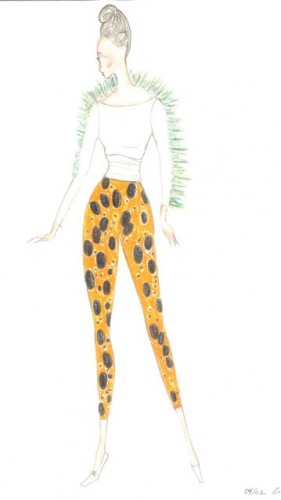

Meg: Your designs are highly influenced by art history and ethnographic traditions, among many other things. How do you meld your varied interests into your practice?
Jude: The things you mentioned are all ways of approaching aesthetics. Ethnographic traditions are really the root of Modernity, which is the defining aesthetic of our time. They are the soul of The Ballets Russes. It’s also evident in the African masks of Picasso and the Pre-Columbian influence in Diego Rivera’s work, as well as the Kachina dolls collected by Max Ernst. For me it’s about distilling the essence of an idea, a moment, a movement.
Meg: You went to China with a film crew a few years ago, and then showed a collection at Mark Wolf Contemporary Art that responded to your experience. What do you value from that opportunity?


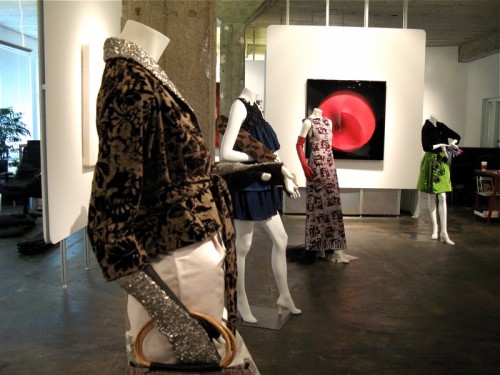
2009 Collection at Mark Wolf Contemporary Art
Jude: In 2009 I was selected to travel to China with fellow designer Colleen Quen and a film crew. We documented the textiles and costumes of the indigenous Hmong villages in South West China. What amazed me is their knowledge of handcraft. From basket weaving and fine wood carving to weaving, embroidery, batik and metalsmithing; a level of hand skill only seen in Parisian Ateliers. Some of the women brought out clothing that had been created generations before. It was amazing to see how well the traditions had been preserved even in the face of privation, cultural revolutions and modernization. It was a great reminder of how beautiful techniques that we romanticize in the West are essentially survival skills. The journey for me was mostly about seeing beautiful things at work, used for their original purpose and not relegated to the purgatory of “decoration” or mere “object.”
After the trip we returned to San Francisco. I made a 12 piece collection based on all the amazing things I had seen. It was a really difficult though transitioning from a mindset of beauty and ornament to a mindset of function and practicality. I suppose ethnography helps me be more honest in my work and strip away the artificiality.
Meg: What specific research do you conduct when you’re preparing to make a collection? What is your process?
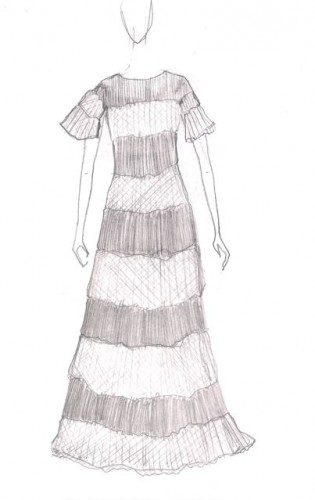
Jude Gabbard, sketch for NadaDada collection.
Jude: When I’m working on a new idea I tend to learn everything I can about the subject that has inspired me. If it’s historic, I want to know everything about that time period. If it’s a film, I want to know everything about that director and see every one of his movies. I’ll even watch an entire movie freezing each scene to make a set of color cards. If it’s a song I need to know who wrote it, their biography, the most popular colors of that year, and any political, philosophical or cultural ideas that might have influenced them. You get the idea. It’s a little obsessive, but what I’m after is finding the essence of the moment – the moment the expression coalesced.
Next I look at the technical side of things; materials, embellishments, colorways. The difficult part is taking all of these moving parts and distilling them into a single functioning idea that adds something new to the dialogue. Unlike painting or sculpture, fashion has the added dimensions of women’s roles and sexuality because of its historic association with femininity and reliance on a human body.
In my current project, now that I’ve swatched my sketches, I’m starting to eliminate pieces that don’t work. I’m looking at silhouettes and pattern pieces, figuring out how to make things tighter, more cohesive and less costumey. There’s a whole process of eliminating anything that seems too derivative of other designer’s work, or too historical. The most successful designs have to be evocative while still being firmly planted in our time and yet somehow a little provocative. If I’m going to ask people to view the world from my perspective, the least I can do is give them something in return.
The last thing I’ll look at is how the garment transforms the wearer. Does the dress wear the owner? Do they look more beautiful, or more exalted, or more themselves? Does it communicate what I intended?
Meg: We’ve been to a lot of art events together. Is there a local artist that’s inspired you recently?
Jude: This is a coat I made for a residency project with specific guidelines. The designs had to be a bit practical and reproducible. I made this last year not long after we saw Bay Area artist Tucker Nichols talk at Baer Ridgeway Gallery. I was looking for inspiration at the time and the artist’s ideas and work resonated. Tucker’s work had a handcraft sensibility and a reduction of form that felt restful and yet contemporary. It seemed simplistic at first, but it had a clear and studied adherence to formal principals. Some of the work even felt more like a classical Japanese painting. The next day I went to work researching more of the Tucker’s published work to get a sense of his vocabulary. I wanted my work to have the same cool frivolity and substance.
(below: Jude Gabbard coat inspired by Tucker Nichols. Nichols drawing on right.)

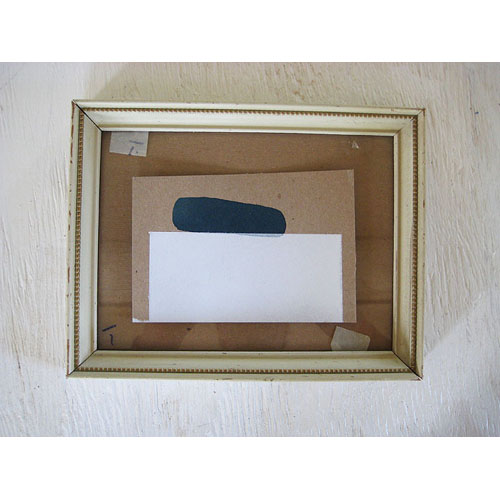
So, using napped wools I came up with this concept two days later. The buttons are antique and the materials recycled. Today I found an image of Tucker’s work and it’s sort of uncanny – from the inlay or layered effect to the gold beading on the frame, there is a palpable synchronicity.
Meg: When we met years ago I quickly discovered that you have an incredible depth of knowledge about cultural history – especially art, architecture and design. Tell us a bit about being a young American boy going off to St. Petersburg, Russia to study fashion design. How was that education foundational for your practice?
Jude: Russia was amazing. It was an opportunity for a European art education unencumbered by the commercialism of American design. I looked at several American schools but the design departments were hyper-focused on capitalism, or worse, they were the poor cousin of art or architecture departments. I wanted to study hand techniques as well as fine art within an academic framework. At that time the best Russian designers were working for state owned fashion houses. As professionals they held their students to the same rigorous standards as architects or engineers. We had hours and hours of painting and drawing and sketching and sewing, but also academic courses in history and hard sciences. St. Petersburg provided unlimited access to some of the world’s greatest art and architecture spanning world history. Learning to view art / objects and put them into context was very much a part of the curriculum. People forget how influential Russia was to the dawn of modernity: The Ballets Russes, Stravinsky, Kandinsky, Vkhutemas (the predecessor to Bauhaus), and Constructivism. It all started in Russia.
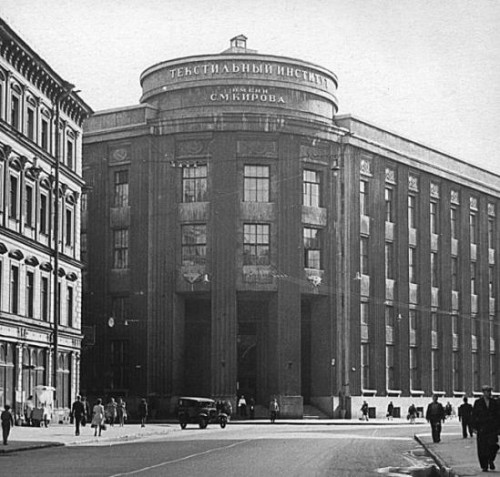
Kirov Textile Institute, St. Petersburg
It was amazing to be in a culture that didn’t reject technique and scholarship outright. Sometimes I feel as though America’s faltering influence as the center of the art world has a lot to do with a rejection of academics. Expressionism as a de facto position seems so old fashioned. I feel like buyers and curators from other countries are asking tougher questions about work. It’s not enough that it smells like freedom anymore. It is the denouement of American art culture.
Meg: We’re great sparring partners when it comes to talking about what makes a work of art, or an artist “great.” When valuing a work of art, the artist’s knowledge of cultural history is very important to you, and goes into your judgment of the artwork. Name a couple works of art, or artists and why you value them.
Jude: Sparring is really the intellectual version of a workout. It’s the only way to clarify theories and actively understand the world. I love our talks. I love viewing art from a curatorial perspective. For me the clash of ideas is where my creativity gets rolling. It’s always illuminating when you call me out on something and at that moment I realize my position was based on some sort of caprice. It makes me investigate more deeply. You should start an art therapy program specifically for artists.
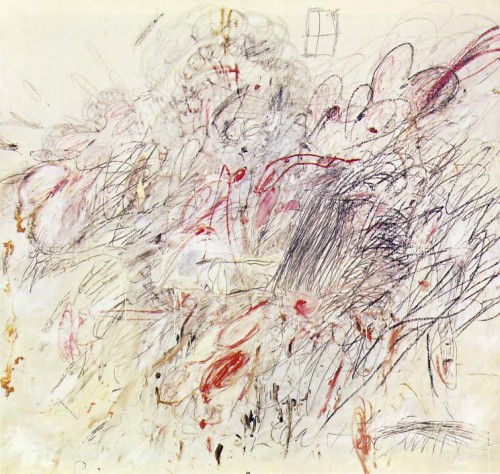
Cy Twombly, Leda and the Swan, 1962. Collection of MoMA, NYC.
Cy Twombly is probably my favorite painter. I went to see his work at the Menil Collection in 2005 after seeing an exhibition in Europe. His work is so crude and yet completely refined. When you compare it to his contemporaries (Jasper Johns, Andy Warhol) the work still looks fresh and exciting. Twombly’s work seems to show a stronger grasp of art history, technique (or rejection of) and the future. There’s no easy narrative here. No can of soup or wood block to hit you over the head. Leda and the Swan is, for me, the quintessential American painting. It represents all the free spiritedness that defines America; it praises graffiti and graphic art while paying homage to the street, mythology and literature. Somehow he manages to coalesce the essence of these seemingly disparate ideas on one humble block.
Cristobal Balenciaga is a huge favorite. He is a master of his metier. You can take any piece and see that the man understands the history of clothing and the history of art. He clearly understands materials, how they’ll drape, how they’ll move and how to combine them in a highly stylized way that doesn’t reject beauty just for the sake of rejecting beauty. Instead he asks us to look at beauty in a different way; to step to the edge and take a look without pushing us to our death.
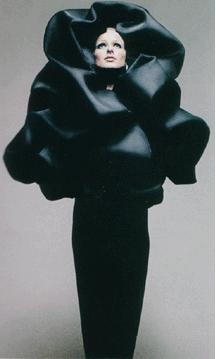
A vintage design by Christobal Balenciaga.
Olga and Alexander Florensky are two of Russia’s most important contemporary artists in the Arte Povera tradition (not unlike Tucker Nichols). They make simple constructs from found objects as well as complicated conceptual projects. In 1995 they created a lost archive of an invented anthropologist and his discovery of the lost YIYE culture. A real coup in the Russian art world at the time, it was so brilliantly executed that even some anthropologists were fooled by it.
A Moveable Beastiary, created by the Florensky’s in the Summer Garden in St. Petersburg in 1998, was the first contemporary art that really spoke to me. A zoo made from cobbled cages and animals constructed from found objects set in a very formal public space with no official permission. It was part agitprop, part whimsy – the result of a lot of thought and a lot of guts. Like their anthropological concept, they get you to participate, and to engage in political and artistic theater. You leave not feeling used or tricked.
It’s a big turn off to talk to an artist that can’t articulate what they’re trying to do. At the same time, art that’s all talk is just as irritating. Rejecting establishment for no good reason just seems awfully silly. I need something in the work that says, “I thought this through because it’s important to me and it needed to be expressed.” Too often though it says, “Look at me; I’m so outrageous, right?”
Meg: For the post next week, I’m going to choose artworks from the SFMOMA collection, and you’re going to sketch some designs in response. Is there anything I should stay away from, or are you game to respond to anything?
Jude: I want to emphasize that fashion isn’t derivative of fine art. It’s another medium, another lens, another approach. I think that will be a fun exercise.
Comments (5)
First, let me say to Jude, we are thrilled to have you join in the fun. Welcome to Reno.
I am one of the Original dis-organizers of NadaDada, and I would like to clear up a small bit of misinformation about the philosophical origins of the event:
This interview (and many, many people) represent NadaDada as being “inspired by the Dada movement of the early 20th c,” and this is actually incorrect – or at least off the mark. The first event, then called Dada Motel, actually had its roots in the Anarchist movement of the early 20th c. Yes, we appropriated the word “Dada” for our purposes, but as the person who first uttered “Dada Motel” over a 4th street brain-storming session with the Noble Instigator, I can assure you that it was largely a phonetic decision. And yes, the connotations are apt and awesome, but the event really had next to nothing to do with the Dadaists or their movement, and I hope that they would appreciate the reckless irreverence of invoking the D-word.
As for A-word, the original show was an exercise in functional anarchy. Independent artists, under their own governance, staging independent shows on an agreed upon week. No organizers – only a core group of six dis-organizers to reiterate the concept, answer FAQs and break up the upstart governments that some participants still felt were necessary to stage a successful event. That’s part of why the first three shows underwent name changes – Dada Motel, Nada Motel, and now the clinging NadaDada – to dispel the sense of organization, continuity, and ownership.
Above all else, it should not be forgotten that the show’s primary intent is to CELEBRATE RENO’S UNLIMITED POTENTIAL FOR ABSURDITY. Our being inspired by Absurdity is really our being inspired by this city. I am genuinely thrilled that artists, museums and media beyond Reno’s borders have taken an interest and want to see how we swing it in the Biggest Little City.
Tova Ramos
Secretariat Maximus
Thank you so very much for letting the world know that Reno is alive as an arts community. I grew up in Los Angeles and studied at the Chouinard Art Institute(now Cal Arts). My move to Reno was an accident but turned into my most prolific and creative times in the studio. This is where I discoverd neon as a powerful medium.
This little city has remained full of young as well as seasoned professional artists. Nada Dada works because it is anti-establishment. No jury. No expectations. Only creative energy.
Vladimar and Rosa love your posts!
Jude Gabbard y Muñoz was born in 1978 in Los Angeles, California. He currently lives and works in San Francisco, California producing his own line under the label modnik ™ as well as couture calibre made-to-order from his design studio off of San Francisco’s famous Maiden Lane.
Collection
Meg, Jude, you two are a great match up! I’m so impressed and can’t wait to meet you in person Jude! NadaDada Motel is blessed to have you in our event. The Trocadero Lounge at Hotel El Cortez was a pretty big deal back in the days before Vegas was what it is today.
We love the aesthetic of this place.. getting older, forgetting it’s past.
Did you know Sinatra performed there back in the day?